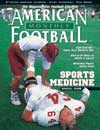AMERICAN FOOTBALL MONTHLY THE #1 RESOURCE FOR FOOTBALL COACHES
Article CategoriesAFM Magazine
|
How to Avoid the Dangers of Lightningby: National Athletic Training Association© More from this issue Lightning storms are among our environment's most spectacular displays. How many times have you caught yourself drawn to the window - or even outside - to watch Mother Nature's fireworks? Opportunities are plentiful. According to the National Lightning Detection Network, 27 million cloud-to-ground lightning strikes occurred in 1997. But disregarding the dangers of lightning is perilous. When those hazards are overlooked during a sporting event or other outdoor activity, the risks become flatly unacceptable. The National Athletic Trainers' Association has developed a Position Statement to aid lightning safety efforts. If you are a parent, a coach, an administrator or a participant, please take note of this information. Background Lightning may be the most frequently encounter....The full article can only be seen by subscribers. Subscribe today!
|
|
|||||||
| HOME |
MAGAZINE |
SUBSCRIBE | ONLINE COLUMNISTS | COACHING VIDEOS |
Copyright 2025, AmericanFootballMonthly.com
All Rights Reserved





